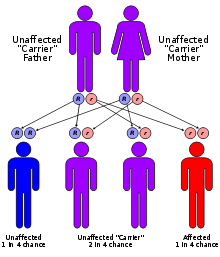- Jervell and Lange-Nielsen syndrome
-
Jervell and Lange-Nielsen syndrome Classification and external resources ICD-9 426.82 OMIM 220400 DiseasesDB 7249 MeSH D029593 Jervell and Lange-Nielsen syndrome, a type of long QT syndrome, causes the cardiac muscle to take longer than usual to recharge between beats. If untreated, the irregular heartbeats, called arrhythmias, can lead to fainting, seizures, or sudden death. The disorder also contributes to hearing loss.
Genetic prevalence
This condition is an autosomal recessive disorder that affects an estimated 1.6 to 6 in 1 million children, and is responsible for less than 10 percent of all cases of long QT syndrome.
Mutations in the KCNE1 and KCNQ1 genes cause Jervell and Lange-Nielsen syndrome. The proteins produced by these two genes work together to form a potassium channel that transports positively charged potassium ions out of cells. The movement of potassium ions through these channels is critical for maintaining the normal functions of the inner ear and cardiac muscle.
About 90 percent of cases of Jervell and Lange-Nielsen syndrome are caused by mutations in the KCNQ1 gene. KCNE1 mutations are responsible for the remaining 10 percent of cases. Mutations in these genes alter the usual structure and function of potassium channels or prevent the assembly of normal channels. These changes disrupt the flow of potassium ions in the inner ear and in cardiac muscle, leading to the hearing loss and irregular heart rhythm characteristic of Jervell and Lange-Nielsen syndrome.
Treatment
Beta-blocker like propranolol if the patients is asymptomatic or there is no documented syncope. Beta-blocker + dual mode/dual chamber/dual sensing pacemaker if the patient is symptomatic or there is documented syncope.
External links
This article incorporates public domain text from The U.S. National Library of Medicine
Genetic disorder, membrane: Channelopathy Calcium channel CACNA1A (Familial hemiplegic migraine 1, Episodic ataxia 2, Spinocerebellar ataxia type-6) · CACNA1C (Timothy syndrome, Brugada syndrome 3, Long QT syndrome 8) · CACNA1F (Ocular albinism 2, CSNB2A) · CACNA1S (Hypokalemic periodic paralysis 1, Thyrotoxic periodic paralysis 1) · CACNB2 (Brugada syndrome 4)Ligand gatedSodium channel Voltage-gatedSCN1A (Familial hemiplegic migraine 3, GEFS+ 2, Febrile seizure 3A) · SCN1B (Brugada syndrome 6, GEFS+ 1) · SCN4A (Hypokalemic periodic paralysis 2, Hyperkalemic periodic paralysis, Paramyotonia congenita, Potassium-aggravated myotonia) · SCN4B (Long QT syndrome 10) · SCN5A (Brugada syndrome 1, Long QT syndrome 3) · SCN9A (Erythromelalgia, Febrile seizure 3B, Paroxysmal extreme pain disorder, Congenital insensitivity to pain)Potassium channel KCNA1 (Episodic ataxia 1) · KCNA5 (Familial atrial fibrillation 7) · KCNC3 (Spinocerebellar ataxia type-13) · KCNE1 (Jervell and Lange-Nielsen syndrome, Long QT syndrome 5) · KCNE2 (Long QT syndrome 6) · KCNE3 (Brugada syndrome 5) · KCNH2 (Short QT syndrome) · KCNQ1 (Jervell and Lange-Nielsen syndrome, Romano-Ward syndrome, Short QT syndrome, Long QT syndrome 1, Familial atrial fibrillation 3) · KCNQ2 (BFNS1}KCNJ1 (Bartter syndrome 2) · KCNJ2 (Andersen-Tawil syndrome, Long QT syndrome 7, Short QT syndrome) · KCNJ11 (TNDM3) · KCNJ18 (Thyrotoxic periodic paralysis 2)Chloride channel TRP channel Connexin GJA1 (Oculodentodigital dysplasia, Hallermann–Streiff syndrome, Hypoplastic left heart syndrome) · GJB1 (Charcot–Marie–Tooth disease X1) · GJB2 (Keratitis–ichthyosis–deafness syndrome, Ichthyosis hystrix, Bart–Pumphrey syndrome, Vohwinkel syndrome) · GJB3/GJB4 (Erythrokeratodermia variabilis, Progressive symmetric erythrokeratodermia) · GJB6 (Clouston's hidrotic ectodermal dysplasia)Porin Categories:- Cardiac dysrhythmia
- Autosomal recessive disorders
- Rare diseases
- Syndromes
Wikimedia Foundation. 2010.

